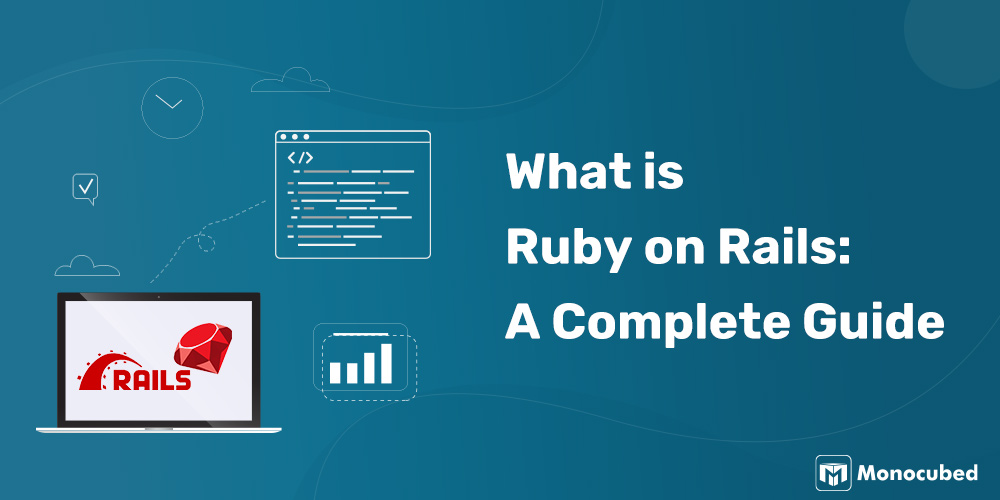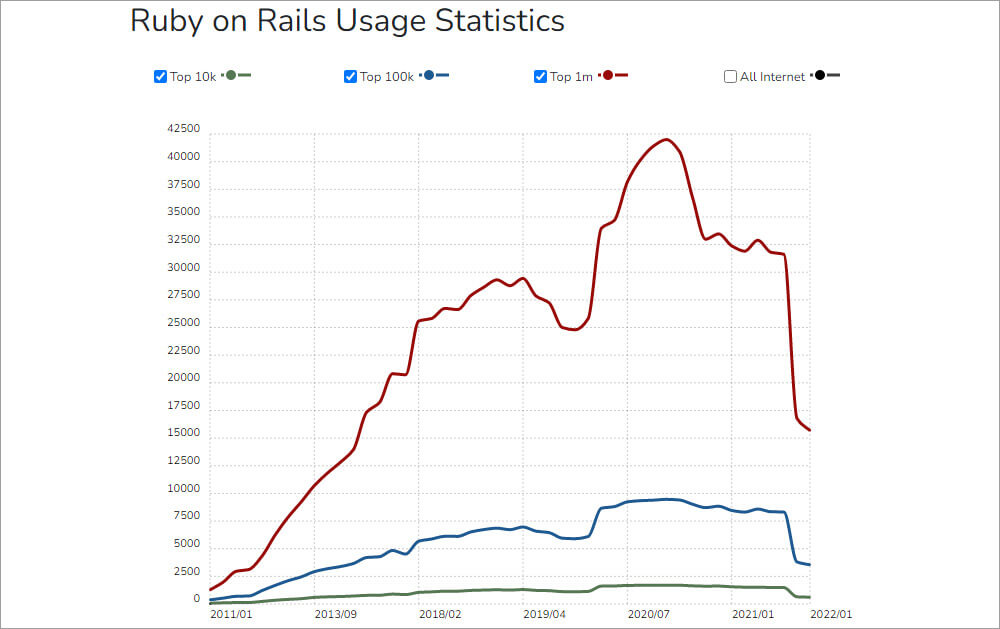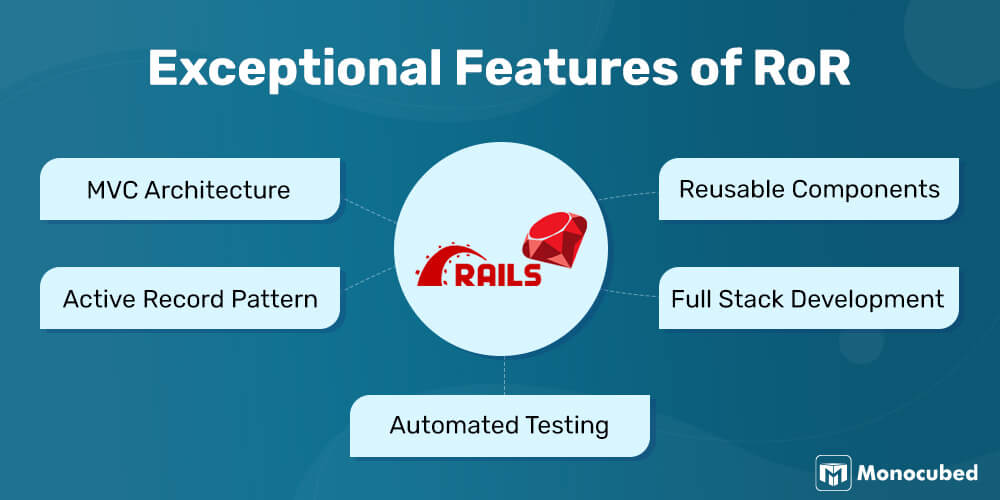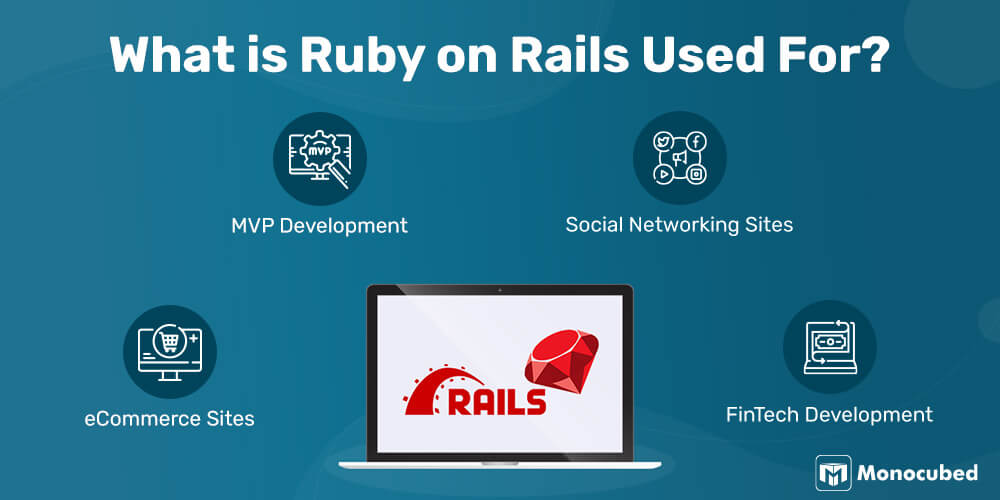There are new web technologies and tools introduced every other week. A framework that is trending right now might become obsolete in a year.
So how do you choose –
- Which technology to use in your web project?
- Which web framework to learn?
- Which programming language to pursue as a career?
We have an answer for you – Ruby on Rails.
Rails is a powerful web framework that has stood the test of time. Developed way back in 2003, it is still a widely-used framework for web application development.
In fact, according to Builtwith, there are 1,162,775 live websites using Ruby on Rails as of April 2022. This proves that Rails is an ever-green web framework and is a safe bet for you.
Source: Builtwith.com
In fact, being one of the leading Ruby on Rails development companies in Canada, we have developed many projects using Rails. Therefore, we have curated this comprehensive guide explaining what is Ruby on Rails, what it is used for, and some outstanding features it offers.
Table of Content
What is Ruby on Rails?
Ruby on Rails (RoR) is an open-source web framework used for developing dynamic web applications and websites. The framework is created with the Ruby programming language and aims to simplify Ruby development.
Ruby on Rails was founded in 2003 by David Heinemeier Hansson “for programmers and coders happiness.”
Ruby on Rails simplifies and streamlines the web application development process. Meaning you start building web applications without requiring a lot of theoretical knowledge. Rails takes care of a lot of background details so that you focus on only developing your application. It provides default structures for web pages, databases, and web services.
Understanding Ruby on Rails With an Example
A simple way to understand the usefulness of Ruby on Rails is by comparing RoR with ready-to-use kits. Imagine you want to build a new cupboard for your house. You could get the raw materials like wood, create a design, take measurements, cut the wood, and hand-build each shelf of the cupboard. That is how you build a web app with Ruby.
But there is a more straightforward, faster alternative – assemble-yourself kit or Ruby on Rails.
The kit contains ready-made shelves and doors and hooks, and nails. You just have to follow the instructions in the guide and attach the parts correctly, and your cupboard is ready. Similarly, Ruby on Rails provides all the components to build a web application simply and efficiently.
You only need to learn the necessary commands and concepts for building your web software. Thus, Ruby on Rails is technical enough to build complex, unique applications without worrying about the background processes.
Want to Develop a Scalable, Modern Web App?
Convert your idea into a modern web application that scales with your business requirements. Get a free quote for developing your custom web solution.
Ruby on Rails is a flexible web framework. Using Ruby on Rails, you develop a variety of websites and web applications such as eCommerce sites, web portal, single-page applications, progressive web apps, and more.
Before we look in detail at what RoR is used for, let’s understand why Ruby on Rails was developed and what problems it solves.
The Design Philosophy of Ruby on Rails
Ruby on Rails is designed to be a very opinionated framework. In short, RoR thinks there is a right way to do things and makes it the default. This way RoR developers by default are following the best development practices while coding.
Thus, Ruby on Rails increases the developer’s productivity and also makes the whole web development process more fun.
Let’s look at the two guiding principles of Ruby on Rails framework –
-
The Don’t Repeat Yourself (DRY) Principle
-
Convention Over Configuration (CoC) Principle
Imagine you built a date input text button for your app. If you want to use the same feature somewhere else in your web app, you might just duplicate it. But in software development, duplicating a code comes with a lot of problems. If you copy-paste a code, you may get unexpected errors, factoring issues, and logical contradictions.
For this reason, RoR is designed on the DRY or Don’t Repeat Yourself principle. In short, DRY means that each entity in your code should have a single, unambiguous, and authoritative definition. If you make any changes in one entity, it is automatically synced to all the other connected entities.
Ruby on Rails developers create small, specific functions that can be easily reused and extended throughout the codebase. You write code once and keep the code clean and modular.
Reuse the code anywhere in your projects by calling the function wherever required. This prevents any logical errors.
The DRY principle allows programmers to work more productively. Ruby on Rails encourages developers to reuse code as much as possible.
Ruby on Rails follows the convention over configuration principle for web development. In short, there is a set of default configurations and conventions that a developer has to follow when developing a Rails web application.
Generally, in many other web frameworks, you have to set up a lot of configuration files before you start coding. But Ruby on Rails takes care of configurations and automatically assigns default values.
By providing default structures for classes, databases, and configurations, RoR makes sure that you don’t waste time on any unnecessary details. You only have to explicitly write code if you want to stray away from the default.
For example, let’s look at the naming conventions in RoR. If you have a class named ‘Product,’ RoR will map it to a table called “Products” in the database automatically. So you only have to write code for mapping if you want to connect your class ‘Product’ to a table “Sale Items.”
This way, you don’t have to worry about the naming of your database fields, classes, and objects. You can directly start programming.
By taking a lot of trivial decisions out of your hands, RoR makes it easier for new developers to start.
The design doctrine of Ruby on Rails is unique and well-defined. The framework is optimized for a programmer’s fun, and DRY and CoC are two base principles for achieving that.
Features of Ruby on Rails
There are a lot of inbuilt features of Ruby on Rails that make it easy to learn and use. As discussed earlier, the framework is optimized for a programmer’s happiness. Compared to other web frameworks such as Node.js, you will find Ruby on Rails extremely intuitive to use. Let’s look at some vital features of the Rails framework that will help you understand RoR better.
-
The MVC Architecture
Ruby on Rails, along with Django, was the first web application framework to popularize the Model-View-Controller pattern for websites and web applications.
So, what is MVC Pattern?
Model-View-Controller or MVC is a type of design architecture for web applications. It defines how a web app will be structured. By using the MVC architecture, you divide your web app into three layers- the Model, the View, and the Controller layer.
You divide tasks and responsibilities between the 3 layers, ensuring the smooth functioning of your web app. Let’s look at the three layers in detail –
- Model – A Model is a Ruby on Rails class that is used to represent data. The Model layer manages all the data and logic of your web app.
- View – View is the component that your user sees and interacts with. The website you see right now, with this blog, is the Monocubed website’s View layer. The View layer controls the graphical interface of your web app.
- Controller – The Controller is the bridge between the View and Model layer. The controller receives the user requests, fetches the data from the Model, and gives it to View to display to the user.
This is how MVC architecture works basically. But Ruby on Rails takes this one step further.
How is MVC Different in Rails?
In Ruby on Rails, the Model, Controller, and View elements are kept in separate folders. This is a default convention of Rails. The view elements should only have code saying how to present data. Similarly, models will only have code for retrieving and storing data. The controllers will have the application logic. The code for each layer is stored in different files, which are stored in different directories.
-
Active Record Pattern
In short, ActiveRecord is the Model in Ruby on Rails. You create model elements in RoR using the ActiveRecord module. It handles the data and business logic of your web application.
So why are we discussing ActiveRecord/Model again? We already know what the Model layer does.
Well, the primary function of ActiveRecord is to handle all tasks related to the database. This means storing, retrieving data, and creating, editing, and removing data in the database.
But that is not all. There are some other additional magic stuff Active Record does –
- ORM – ORM or Object-relational Mapping is a method of connecting the rich objects of your web app to tables in your database. You store the data and define how that data is related to other data, all in a single place, without needing to write SQL statements for each relation. Active Record does that for you in Rails.
- CRUD Operations – Active Record handles all the Create, Read, Update, Delete (CRUD) operations in your database. RoR simplifies how your app works with your database using ActiveRecord.
- Data Validation – With ActiveRecord, you validate the state of a model before it gets written into the database. ActiveRecord ensures that the data is correct, unique, and well-defined before storing it in the database.
-
Reusable Components
We discussed the Don’t Repeat Yourself principle in the above section. How does RoR implement the DRY principle? By making all components reusable.
Experienced Ruby on Rails developers knows how tiring it is to write the same code over and over. Rails provides reusable components, so you don’t have to rewrite or duplicate code. You can reuse the same code across different projects and modules.
Ruby on Rails follows object-oriented programming concepts like data abstraction and inheritance, making it easy for Ruby programmers to track and reuse their code without causing any errors or logical fallacies.
-
Full Stack Development
Rails is a complete web application development tool. You develop both the frontend and backend of a website with Ruby on Rails.
RoR uses Ruby programming language to build a robust backend. HTML, CSS, and JavaScript web programming languages are used to build the front-end of the website. This is why Rails is called a full-stack framework.
Therefore, you learn both front-end and back-end development skills and can be called a full-stack Ruby on Rails developer. This simplifies a lot of work for you as a developer.
-
Automated Testing in Rails
Ruby on Rails provides a very easy testing framework for developers. You quickly write tests for your web apps with RoR.
Rails creates a test directory automatically as soon as you create a new Rails project. It has different directories for different tests – controllers, models, views, helpers, integration (for integration testing), system tests, and more. When you create a model or controller, RoR also creates a skeleton Ruby code for testing.
Additionally, RoR also helps you test your web app’s response to user requests. It will send browser requests to your server, so you don’t have to test your app through different browsers.
RoR also has a default testing library called Minitest. Apart from this, Rails also supports the Rspec testing framework, which is generally preferred by most developers.
So, we have discussed the most important features of Rails. There are a ton of other functionalities offered by Rails that makes it an ideal choice for web development.
Now let’s look at what kind of projects you can build with Ruby on Rails.
What is Ruby on Rails Used For?
So all these features are excellent, but what kind of apps can I build with Ruby on Rails?
- Is Rails good for building blogging websites?
- Is RoR good for developing an eCommerce web app?
- Will RoR work for a stock market analysis app?
Rails is a very versatile framework. You can outsource your project to RoR development companies to build a variety of Rails applications ranging from an eCommerce platform and payment gateways to static websites, social media applications, and browser games.
Let’s look at the major kind of web apps you build with Ruby on Rails –
-
eCommerce Application Development
When it comes to developing eCommerce solutions, Ruby on Rails is the first choice. With the data security, scalability, and reusability RoR provides, it is apt for developing secure eCommerce web apps. Plus, it is extremely easy to build Rails eCommerce websites because of the many Ruby gems available. You can attract customers with an easy-to-use web store that conducts safe payments and supports thousands of simultaneous users.
-
Social Networking Sites
There are many social networking sites and web apps that use the Ruby on Rails framework, such as Dribbble, GoodReads, and Fiverr. You can build large-scale social media web applications using RoR. It provides the performance, user request handling speed, and scalability that will help you build a trending social networking site for your business niche.
-
FinTech Development
Ruby on Rails helps you eliminate the many coding challenges of banking, insurance, transactions, and payment services. With the security and testing that RoR offers, Ruby developers can easily build secure FinTech solutions. With huge community support, you can navigate complex, large projects with limited budgets and time.
-
MVP Development
Rails is the perfect choice for startups and entrepreneurs looking to try out new ideas. It is easy to use, maximizes the developer’s productivity, and comes with a wide range of Ruby gems for every kind of feature imaginable. In fact, it is often called startup technology. If you are looking to develop a Minimum Viable Product (MVP) for your idea, hiring Ruby on Rails developers is the best choice for you.
Develop Your Own Social Media Web App
Our Ruby on Rails developers will assist you in developing a custom social media web app with all the features you require. Contact us today and start developing.
Frequently Asked Questions
-
Is Ruby on Rails dead?
No, Ruby on Rails is very much alive and still used to build web applications. The Rails community is very active with experienced developers constantly guiding and helping new RoR developers. Web developers prefer Ruby on Rails because it is a fun and productive framework. It lets developers focus on coding, using defaults to minimize the developer’s work.
-
What is Ruby on Rails good for?
Ruby on Rails is best for startups and entrepreneurs developing new products. Rails was built for developing high-quality web apps with limited time. RoR is good for developing minimum viable products, eCommerce stores, scalable websites, social media platforms, and real-time applications.
-
Is Ruby on Rails easy to learn?
Ruby on Rails is very beginner-friendly. You need to have knowledge of only Ruby programming language and a few basic concepts of web development to start working with Rails. RoR takes care of a lot of background details automatically, so you don’t need to know everything. Moreover, RoR is very close to the English language. Thus Ruby on Rails framework is extremely easy to learn and understand.
Conclusion
Rails is a robust framework for developing modern websites and web apps. Whether you are a beginner looking for a web technology to learn or an experienced programmer looking to add a new web framework to your repertoire, Ruby on Rails is a good choice.
Building scalable, cost-effective web apps within a limited time is easier than ever using RoR. We say this from our experience. As a web development service provider, we have used Ruby on Rails in a lot of our web projects, such as Fieldcamp.
Have a web app idea in mind?
Contact our team to convert the idea into a high-earning Ruby on Rails web app.
 By Jeel Patel
By Jeel Patel






